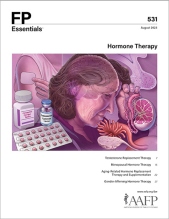
This clinical content conforms to AAFP criteria for CME.
Approximately 0.6% of adults (1 to 1.4 million adults) in the United States identify as transgender, and 2% of high school-aged individuals (150,000 to 300,000 individuals). Gender-affirming care for transgender and gender-diverse patients can include support with social transition or physical presentation, legal steps, and medical treatments (eg, hormone therapy) and surgeries. Adolescent and adult patients who request gender-affirming hormone therapy must meet several criteria. One is confirmed persistence of gender dysphoria or gender incongruence. Also, the patient must have reached the age of legal medical consent and be able to consent to therapy. For adolescent patients who are minors, meeting of additional criteria is recommended. In eligible adolescent patients, gender-affirming hormone therapy consists of two phases, pubertal suppression and then feminizing or masculinizing hormone therapy. Before puberty, hormone therapy is not recommended. When puberty begins, patients can receive a gonadotropin-releasing hormone agonist to suppress puberty (ie, puberty blocker). Feminizing or masculinizing hormone therapy, which usually is initiated at age 16 years, consists of estradiol or testosterone, respectively. For adult patients requesting gender-affirming hormone therapy, a thorough evaluation should be performed to assess for contraindications and conditions that may increase therapy-associated risks. Feminizing hormone therapy includes estrogen and an antiandrogen, and masculinizing therapy consists of testosterone. These patients should undergo regular monitoring. Cancer screening is based on risk factors, organ inventory, and screening guidelines.
Subscribe
From $350- Immediate, unlimited access to FP Essentials content
- 60 CME credits/year
- AAFP app access
- Print delivery available
Edition Access
$44- Immediate, unlimited access to this edition's content
- 5 CME credits
- AAFP app access
- Print delivery available
